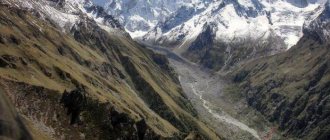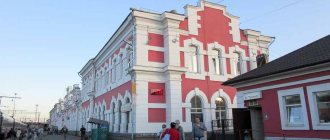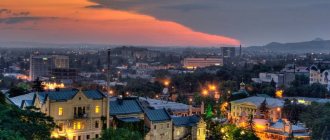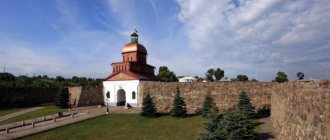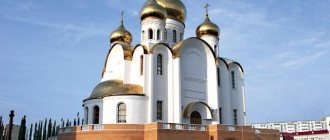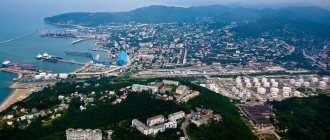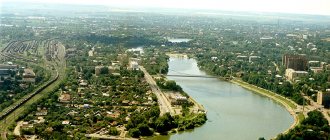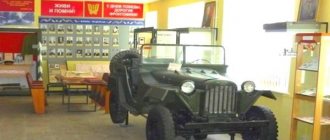North Ossetia and Alania, unlike Adygea and Caucasian Mineralnye Vody, are not the most popular holiday destinations for tourists.
Vacationers are attracted to the republic:
- mountain rivers;
- beautiful mountain ranges;
- reserved springs.
Whenever a tourist comes to the republic on vacation, he is always a welcome guest.
Holidays in North Ossetia and Alania will fill vacationers with impressions; the article contains all the most interesting objects of the republic, which are definitely worth seeing here in 2021. The capital of the republic is the city of Vladikavkaz.
Climate and weather of North Ossetia
North Ossetia-Alania is located on the territory of the North Caucasus, is included as a republic within the Russian Federation, and is located in the temperate continental climate zone. Temperate continental air masses dominate all year round. The republic is divided into two main zones - Steppe Atlantic Continental and Mountain. Each includes different climatic regions and regions.
It borders on the south with Georgia and South Ossetia. It is part of the Sevaro-Caucasian Federal District. It is located in the south of the European part of Russia, in the foothills and on the northern slope of the Main Caucasus Range.
In the Tersko-Kuma Lowland, average January temperatures are from –3.5 to –4 °C, July 23–24 °C, droughts and hot winds are frequent. On the North Ossetian Plain, average temperatures in January are from –4 to –4.5 °C, in July 20–21 °C. The frost-free period in the plains is 190 days.
Annual precipitation increases from north to south, on the plains from 400 mm to 800 mm, in the mountains up to 1200 mm, decreasing in the basins to 370 mm. Most of the precipitation falls in May–July. The height of the snow cover ranges from 10 cm on the plains to 60 cm or more in the mountains. Mountain-valley winds and hair dryers are typical.
Developed glaciation is observed on the territory of the republic. There are about 250 glaciers, whose area is about 170 square meters. km.
The largest among them are:
- Karaug.
- Tsya.
- Midagrabinsky.
- Miley.
- The pulsating Kolka glacier.
Modern glaciation has almost halved over the past 100 years. There are more than 84 rivers in the republic, the length of which is 10 km or more. Most of the rivers belong to the Terek basin.
There are also more than 130 lakes here. Most of them are small and of glacial origin; there are also lakes of karst origin. The largest lake is Huricau
Features of the region
North Ossetia is not a Muslim republic. And yet, it is also customary here to follow certain rules in clothing: women should not wear miniskirts, see-through items or short tops. Men - shorts and sleeveless T-shirts.
In addition, women are not allowed to enter sanctuaries (zuars). In appearance, they resemble gazebos with tables and benches; most often, they are found along roads and are always fenced. In fact, these are religious objects.
Communication in the mountains does not work. First download one of the offline maps to your smartphone to make it easier to navigate the area.
How to get to North Ossetia and Alania
The easiest way to get to Vladikavkaz is by plane from Moscow. Currently, four airlines operate flights from the Russian capital to Vladikavkaz, including one low-cost airline. Flight time is 2 hours. Vladikavkaz Airport is located near the city of Beslan. You can get from here to the capital of the republic by city bus.
The capital of the Republic can also be reached from Moscow by the Moscow-Vladikavkaz train; a train runs from St. Petersburg to Vladikavkaz. The journey takes up to 1.5 days. The train runs from the northern capital 2-3 times a week. The railway station is located at: Vladikavkaz, st. Markova, 24.
From the central regions of Russia you can get to the Transcam highway by car. You can get to the capital of the republic along the Georgian Military Road from Beslan and along the P295 highway from Nalchik.
Cities of the Republic of North Ossetia - Alania
Vladikavkaz is the main city of the republic. The capital of Alanya is home to 330 thousand people, mostly Ossetians and Russians. This city gave Russia many cultural figures. Valery Gergiev alone is worth something. Now the city is going through hard times, but there is a positive trend.
Mozdok is the second largest city in North Ossetia. Unlike Vladikavkaz, the Russian population predominates here. More than half are Russian. For many years, Mozdok belonged not to Alania, but to the Stavropol Territory, and was transferred to North Ossetia during the Great Patriotic War. Approximately 40 thousand people live here. There is very little work.
Where to stay on vacation
While on vacation, tourists can take full advantage of the capabilities of numerous mountain rivers. Here you can swim, raft or kayak downstream.
The main rivers of the region, feeding their water reserves from mountain glaciers:
- Terek;
- Ardon;
- Urukh.
Among the foothill rivers, Sunzha and Kambileevka are distinguished, which do not freeze even in winter.
The glaciers of Ossetia always attract fans of mountaineering, who try to take advantage of the opportunity to climb one of them. Maili and Tseysky are considered the largest here, but the championship rightfully belongs to Karaugomsky, whose area reaches 35 square kilometers.
Having visited any of the tourist centers, the vacationer has the opportunity to become closely acquainted with the unusually rich flora of the mountain region, to visit the vastness of its alpine and subalpine meadows.
In the forests, extending over a fifth of the territory, the plant world is dominated by:
- Beech.
- Hornbeam.
- Linden.
- Maple.
- Ash.
Traveling along forest paths, you can enjoy the fruits of wild bushes that abound around you. Fans of hunting will receive unforgettable pleasure from the abundance of game living in the forest thickets. As a trophy you can get a roe deer, a lynx, a hare and a host of other animals.
While on vacation in the resort area of the North Ossetian Territory, you have the opportunity to get acquainted with the people living here, enjoy their cordiality and hospitality. In these parts people remember and know their own ancestors up to the seventh generation. It is customary here to invite guests not out of politeness, but from the heart, setting the table with all the dishes that are in the house.
The main attraction of the North Ossetian Territory is the mountainous regions. Here you can truly enjoy the splendor of the surrounding mountain beauty.
At any tourist base, the staff will provide the opportunity to take part in an excursion tour through the protected corners of this extraordinary region.
I have an opportunity:
- visit historical places;
- enjoy the clean mountain air;
- get unforgettable pleasure from walks in forests.
Mountain resorts have been preserved in Ossetia since Soviet times.
Among them are the most famous:
- Dzinaga.
- Tsey.
- Fiagdon.
In recent years, new formats have begun to spontaneously develop in these long-promoted places.
Most popular resorts
North Ossetia is one of the calmest republics of the North Caucasus. The last armed ethnic conflict occurred in 1992. The only real danger for tourists is horsemen driving cars.
The recreational and tourist base “Harp” in the village of Akhsau, opened in 2015, has become incredibly popular.
Minimal but sufficient comfort, beautiful place, all-inclusive tours. Perhaps the ideal place for a family holiday in nature. The Taymazi sports and health tourism base is the best place for the young and active. A great chance to try your hand at paragliding.
Fiagdon is the closest mountain resort to Vladikavkaz. Here you can stay in one of the most famous art hotels - “Fiagdon”. The location and proximity to the best restaurant in Fiagdon, “Valley of the Sun,” make the choice of the hotel obvious.
An alternative to a serious hotel is a youth tourist hotel. The prices are moderate, everything is of good quality, but without comfort or frills. Fiagdon has a large selection of private houses that are rented out to vacationers - from modern designed villas to timber cottages and old dachas.
In Tsey, a favorite among tourists is the Vertical Hotel. The cost of living there is 4000 per room with breakfast and lunch.
Directly from the hotel, the trail leads to a beautiful waterfall. The only problem is that there is no Wi-Fi and the mobile Internet works very poorly.
An alternative to “Vertical” are cheaper ones:
- "Victoria";
- "Fairy tale";
- the iconic Soviet alpine camp "Tsey".
The options for overnight accommodation in Vladikavkaz are varied: from the hostel with the very accurate name “One” to the “Alexandrovsky” hotel with an honest four stars. This hotel is one of the best in the North Caucasus. We can also recommend the Imperial Hotel, it has a solid three stars.
There are several three-star hotels in the city that cost 2–2.5 thousand rubles per room - half the price of the Imperial. There is also an exotic place to stay overnight in the historical center of the city - a tent camp in the art space "Portal".
Sights of North Ossetia and Alania
North Ossetia is an amazing place. Holidays in North Ossetia will be a great way to relax in an environmentally friendly environment, have fun and play sports. The Republic provides an opportunity to inexpensively spend time in the fresh air outside the city, with friends and family.
While relaxing in North Ossetia and Alania, you can get acquainted with local natural and historical attractions, of which there are a large number on the territory of the republic.
Midagrabin waterfalls
Midagrabinsky waterfalls are a place in the upper reaches of the Gizeldon Gorge, where meters matter. They are also called the valley of waterfalls due to their multi-cascade nature. They are considered the highest in Europe and are only slightly inferior to Angel, Tugela and Yosemite Falls, but, unlike them, are not so famous. Their lack of fame does not make this attraction any less majestic and attractive.
The largest of them is Big Zeygalan. The height of the continuous fall of water is 750 meters. The waterfalls are located in the border zone, so you need to have a passport with you in case of inspection.
To see the Midagrabinsky cascade in all its powerful glory, you need to go in late July-early August. These waterfalls are seasonally pulsating, fed by a melting glacier, so they gain “fullness and grandeur” only in the summer. By the way, the noise from the water here is so loud that you can’t hear the words of your interlocutor nearby.
"City of the Dead" Dargavas
Holidays in North Ossetia in 2021 will be incomplete without seeing Dargavs - the calling card of the republic. The Ossetian city of the dead is under the protection of UNESCO.
Local residents try not to go inside the necropolis unless necessary, so as not to disturb the souls of the dead and do not come close after sunset. They have not been buried in Dargavs since the 30s of the 19th century, when the process of resettlement of the highlanders to the plain began. Now it is more of a tourist pilgrimage site.
After the collapse of the Kolka glacier in 2002, the road leading to the village was destroyed, and Dargavs was left without communication with the outside world. You can get here only along a mountain serpentine road, which begins in the Fiagdon Gorge. The road is difficult, but the scenic beauty of the place is worth it.
There are three types of crypts in the “city of the dead”:
- Those that are completely underground.
- Semi-underground.
- Ground.
The necropolis has 97 tombs, the stone quadrangular roofs of which resemble pyramids or oriental pagodas. Thanks to them, the crypts remain dry even during heavy rains. Water flows down the roof in cascades and does not get inside the buildings.
Secret fortress Dzivgis
The village of Dzivgis in the Alagirsky district of North Ossetia is hidden between the hills of the Kurtatinsky gorge on the banks of the Fiagdon River, just 40 kilometers from Vladikavkaz. But before you go to the fortress, take a walk around the village. Many of its houses are already empty, but it is considered a place of power in the Caucasus.
The cultural complex here is dedicated to the pagan patron of men - Uastirdzhi. According to legend, one day it snowed in Dzivgis, and there was only one place left that was not covered with snowdrifts. On it, residents discovered hot chains from which steam emanated, and the ground around them was completely snowless. People realized that this was a gift from heaven and decided to build a sanctuary on this place.
Each such place has a custodian dzuarlag and several of his assistants. Caretakers organize temple festivals, monitor rituals, and keep records of donations. These people constitute a special caste and enjoy great authority among fellow villagers and visitors. The position is inherited from father to son. They are also bearers of wisdom; villagers go to them for advice on all issues.
Tower of brothers Kurt and Tag
Like every place in the Caucasus, this one also has its own legend. It's about two brothers, Kurt and Taga, who were quarreled by a falcon, and in order to avoid trouble, they decided to separate forever.
But, to be honest, this legend is nothing compared to the developed sense of beauty of two Ossetian relatives. Because only people who understand beauty could choose such an incredible place as a site for their home. All synonyms for the word “amazing” pale in comparison to what you can see here in person. It’s worth coming here not for the legend, but to climb to the top and feel your heart grow larger from the beauty you see.
Karmadon Gorge
The fate of Sergei Bodrov and his film crew made the Karmadon Gorge famous throughout the country, and the Kolka glacier almost destroyed it as a tourist destination. Meanwhile, it cannot but be included in the top beauties that need to be seen in North Ossetia.
From the high point of Karmadon there is a panoramic view of the gorge, cut by the Genaldon River, and this landscape can easily compete with Swiss views. There are mineral springs here, bathing in which improves vitality and immunity. For example, 40 meters from the Maili glacier, around the springs, there are even small stone baths. Well, in fact, the road to Dargavs lies through it.
You can get here by car. In this case, you need to follow the Vladikavkaz-Alagir road, turning at the fork to Karmadon. You can book a tour at a travel agency or come by bus from Vladikavkaz.
Not far from here, in one of the tunnels, hangs a memorial plaque with a photograph of Bodrov. His character in the film “The Messenger” was supposed to die due to a glacier collapse. This is what happened in reality... The inscription on the memorial wall is: “If the time has come for a person to die, then the one who loved him will not stop loving him!”
Distinctive features and history of North Ossetia
On the “What Where When” program, after a question from Ossetia, a black box was opened with dogs.
Folk humor Unfortunately, any mention of the North Caucasus causes panic among average Russians. The Chechen wars intimidated our fellow citizens so much that they see every Caucasian as a Wahhabi thug. People look warily at Caucasians in the subway and avoid them at train stations and airports. It’s completely in vain, because the vast majority of the population of this territory are nice and adequate people. And especially the Ossetians, who dote on Russians.
Most of the representatives of this nation, by the way, are Orthodox. They were the first to voluntarily enter into an alliance with Russia and never had separatist sentiments. Everything that they say about Caucasian hospitality is absolutely true, and we need to treat these people with great confidence. There can be no talk of any hostility between Ossetians and Russians. True, local residents have a bad attitude towards mixed marriages, but this is everywhere in Russia.
Sanctuary of Dzyvgysy dzuar. Photo by lidk-a (https://fotki.yandex.ru/users/lidk-a/)
The first mention of the Alans, the indigenous population of the Republic of North Ossetia-Alania, dates back to the first century BC. Later, Alanya arose on this territory. It occupied vast areas from the Caucasus to Ukraine and the Volga region. The Alans repeatedly suffered from the raids of the Huns. The Alans did not miss the Great Migration of Peoples, as a result of which most of the local population went to Western Europe, Crimea, and the Don and Dnieper basins.
The famous Georgian Queen Tamara is the granddaughter of the King of Alania Khuddan. After the Mongol invasion, the Alanian kingdom ceased to exist. This territory was divided between the Georgians and the independent Ossetian principalities, mired in internecine war. The annexation of North Ossetia to Russia took place in 1774. Vladikavkaz became the first Russian fortress in the North Caucasus. Thousands of Ossetians served as volunteers in the Imperial Army. Among them were even 40 generals.
During the Great Patriotic War, fierce battles with fascist invaders took place on the territory of North Ossetia. The Republic was occupied by the 1st Panzer Army of General Kleist. Another armed conflict occurred in North Ossetia in the early 90s. This time the Ossetians took up arms not against the Nazis, but to confront their neighbors - the Ingush. The Ingush laid claim to the Prigorodny region of North Ossetia, which, of course, did not please the Ossetians. At the moment, the conflict has not exhausted itself, but new clashes are not occurring, and thank God. During a bilateral meeting in December 2009, a Joint Action Program for the development of good neighborly relations between the Republic of North Ossetia-Alania and the Republic of Ingushetia in 2010 was signed between the presidents of the republics of Ingushetia and North Ossetia-Alania.
The Chechen wars also did not pass North Ossetia by. Ossetians are Orthodox and have always been peaceful towards Russians, and they probably paid for it. The Chechens have repeatedly organized terrorist attacks on government facilities in the republic, the most terrible of which occurred at a school in the city of Beslan. That terrible day of September 1, 2004 will forever remain in the memory of the Ossetian people.
Memorial wall of school No. 1. Photo by Konstantin Farniev (https://fotki.yandex.ru/users/everfastman/)
Geographical position
The Republic of North Ossetia is located on the northern slope of the Greater Caucasus. Mountains occupy slightly less than half of the region's territory, the rest are plains and lowlands. In the north there is the Stavropol Plain, in the south there is the Main or Vodorazdelny ridges, in the central part of the republic there is the Ossetian Sloping Plain.
Population
The population of North Ossetia, according to the latest data, is 704 thousand people, slightly less than half of them live in the capital, Vladikavkaz. The republic is very rich in ethnic composition. Ossetians, Russians, Georgians, Armenians, Ingush, Kalmyks, Azerbaijanis and other nationalities live here.
In a multinational society, interethnic conflicts cannot be avoided. Adults, fortunately, do not take up arms, but, for example, Ossetians and Ingush are on very cold terms. In local schools, children are often grouped according to nationality, but this is observed not only in the North Caucasus, but throughout the country, where many nationalities are represented in one place.
Evening Vladikavkaz with Mount Kazbek in the background. Photo by muradiish (https://fotki.yandex.ru/users/muradiish/)
Traveling around North Ossetia, it makes absolutely no sense to take a tent with me. In mountain villages they will always shelter and feed a traveler, no matter who he is.
Some local traditions may seem wild to Russians, but they can be attributed to national flavor. For example, weddings here look simply unforgettable: a huge noisy escort, shooting in the air. Locals joke that at the next stage of the Paris-Dakar Rally, a wedding escort from Ossetia won.
Crime
The turbulent times when in North Ossetia someone could be kidnapped on the street in broad daylight, thank God, have sunk into oblivion, but even now the region is not calm enough. From a statistical point of view, Alanya does not stand out in any way in the all-Russian crime rate, but sometimes incidents, contract killings and even terrorist attacks occur. For example, in 2008 in Vladikavkaz, former mayor Kazbek Pagiev was shot in broad daylight. The official's personal driver was also killed along with him.
In 2011, the famous poet and public figure Shamil Dzhikaev was killed by a Muslim fanatic in Vladikavkaz. His body was found by police at approximately 15.00 near the village of Redant. The police went to the place indicated by unknown persons who called the duty station. Near the support of the cable car lay a corpse with a severed head barely hanging on to the neck. It is impossible not to note the place of corruption in North Ossetia. Bribes are taken everywhere, but especially here. Apparently, the Caucasian mentality is taking its toll:
— In the 18th century, Ossetia became part of Russia, but Catherine the Second did not accept Chukotka. - Well, right, what are they up to with their skins? It should have been like us - flowers, champagne, sweets... Well, what woman can resist, huh?
Unemployment rate
In North Ossetia, the job situation is good only in the capital of the republic, Vladikavkaz. Metallurgical industry enterprises are located there: “Electrozinc”, “Pobedit”, “Crystal”. Many local residents earn extra money as private drivers. The tourist flow to the republic has not yet been established. Nobody needs Soviet health resorts; Russians are afraid to travel to the North Caucasus.
According to statistics, 65% of all counterfeit Russian vodka is produced in Alanya, but in reality this percentage can reach up to 90%. It's no joke, in Ossetian villages you can buy Hennessy X.O. for 250 rubles.
Alcohol can also be purchased at a regular kiosk.
The official average salary in the republic is 18,000 rubles, but in reality it is approximately equal to 12,000.
Property value
Small villages of North Ossetia are a real paradise for squatters. There are a sufficient number of abandoned apartments and houses here. There are few abandoned buildings in Vladikavkaz itself. A good one-room apartment in the main city of the republic will cost a little less than a million rubles. If you wish, you can find options for 700 thousand.
Climate
The climate in Alanya is moderate continental. Due to the difference in altitude, it is different in different areas. On the Mozdok Plain the climate is arid, with frequent dry winds. In January, the average temperature is −4.4 °C, in July - +24 °C, annual precipitation is only 400-450 mm per year. In the Central and Piedmont regions the climate is milder because the mountains are close. In summer, tropical cyclones often penetrate here with heavy rains, which are often accompanied by thunderstorms.
Mountains of North Ossetia. Photo by yperv602009 (https://fotki.yandex.ru/users/yperv602009/)
What to try and what to bring as a gift
It’s worth coming to North Ossetia not only for the natural and cultural attractions. The republic can also be visited because of its unique national cuisine.
The king of Ossetian cuisine is meat. Lamb is especially respected in Ossetia. For example, a dish such as lyvzha is a stew of meat with potatoes and onions, seasoned with pepper, garlic and savory. In addition to stewed meat, lamb is loved in the form of shish kebab, not only from the sirloin, but also from offal. In this case, the kidneys, liver and heart of young animals are threaded onto wooden skewers and fried over coals.
The sauce with which the dish is served is also important:
- tsakhton made from sour cream;
- Nury Tsakhton - very spicy garlic.
One of the iconic dishes of Ossetian national cuisine is pies. Ossetian pies are not food, they are the religion of the nation. A pie with cheese will never be served alone, but three plates with them will be placed on the table. They symbolize the sun, water and earth - the three foundations of the universe.
The most popular are pies with cheese - olibach. In addition, Ossetians also prepare other pies with different fillings.
Among them are:
- Tsakharadzhin - with cheese and beet leaves.
- Khaedurjyn - with minced boiled chopped beans and lard.
- Nasjin - with pumpkin.
- Kabuskajin - pie with cabbage and cheese.
Pies are often served instead of bread with main courses. You can wash it all down with iron bagane, a dark Ossetian beer with a rich taste, or a shot of barley arrack.
For dessert, you can eat halua - small balls of dough that are prepared using melted butter and powdered sugar.
To purchase souvenirs, you can visit the following shops in Vladikavkaz:
- "Fatima";
- "Souvenirs of the Caucasus";
- "Tsarazon" and some others.
One of the gifts from Ossetia could be a dagger. Decorative items with beautiful handles, decorated with precious stones or with stunningly beautiful carvings can be found in almost any gift shop. Prices start from 500 rubles for the simplest souvenir dagger, and for a real one, not a souvenir one, you will have to pay an amount of 2000 rubles.
No less popular souvenirs are:
- Key rings.
- Wooden figures.
- Paintings depicting Uastirdzhi - the patron saint of men, a mediator between people and God.
In North Ossetia, products with the image of Uastirdzhi are considered a talisman and bring good luck to warriors. The price for a bronze keychain starts from 650 rubles. You can take Ossetian cheese with you as an edible souvenir. It is recommended to buy it at the Central Market of Vladikavkaz

